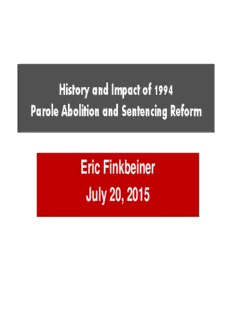
History and Impact of 1994 Parole Abolition and Sentencing PDF
Preview History and Impact of 1994 Parole Abolition and Sentencing
1994 History and Impact of Parole Abolition and Sentencing Reform Eric Finkbeiner July 20, 2015 1994 Criminal Justice Reform Objectives in The abolition of parole was a key issue in the 1993 gubernatorial campaign. The new governor formed a commission to develop a comprehensive sentencing reform plan. − Town hall meetings – citizen concern over lack of transparency in the system − Review of federal guidelines and experiences in Florida, North Carolina, Pennsylvania and Texas − Thorough examination of historical sentencing and time served 2 Under the parole system, Virginia’s inmates were serving a fraction of the sentences ordered by the court. Average Prison Sentence and Time Served for Inmates Released in 1993 40 35 35 30 Prison Sentence 25 Time served s r 20 a e Y 15 17 14 10 10 9 8 5 7 7 6 4 4 3 4 2 2 0 1st D. 2nd D. Rape/ Robbery Mal. Burglary Sale Sch. Fraud Murder Murder Sodomy Wounding I/II Drug Source: Governor’s Commission on Parole Abolition & Sentencing Reform – 3 Final Report (August 1994) Most offenders convicted of violent felonies in 1992 were identified as having prior criminal convictions. Percent of Convicted Violent Felons with Prior Convictions 1992 100% 80% 87% 82% 79% 76% 68% 60% 40% 20% 0% Robbery Assault Murder/Mansl. Sexual Assault All Violent Felons Source: Governor’s Commission on Parole Abolition & Sentencing Reform – 4 Final Report (August 1994) Virginia’s violent crime rate had begun to increase significantly in the late s. 1980 Virginia Prison Incarceration Rate and Violent Crime Rate (1975 - 1992) Rate per 100,000 400 Violent Crime Rate 300 200 Incarceration Rate 100 1975 1980 1985 1990 1992 Source: Governor’s Commission on Parole Abolition & Sentencing Reform – 5 Final Report (August 1994) Virginia’s Sentencing Reform Legislation (1994) Goals of Sentencing Reform: Abolish parole Sentencing reform Establish truth-in-sentencing provisions took effect for (minimum 85% time served) felonies committed on or Target violent felons for longer a f t e r January 1, 1995. terms of incarceration Keep the average time served the same for nonviolent felons Redirect lowest-risk nonviolent felons to less costly sanctions Expand alternative punishment options for nonviolent felons Reduce sentencing disparities Create a sentencing commission to oversee voluntary guidelines system 6 Under truth-in-sentencing, felons are serving at least 85% of the sentence ordered by the court. Percentage of Prison Sentence Served 85% Parole system data represent FY1993 prison releases; truth-in-sentencing data is derived 7 from the rate of sentence credits earned among prison inmates as of December 31, 2013 Guidelines Midpoint Enhancements for Violent Offenders (pursuant to § 17.1-805) Guideline midpoint enhancements Cases with (ranging from 100% to 500%) Violent Offender Enhancement produce sentence recommendations 22% for violent offenders that are significantly longer than the time served by these offenders under the parole system. Offenders who are convicted of a violent crime, or who have been previously convicted of a violent Cases without crime, receive these enhancements. Violent Offender Enhancement Approximately one in five felons 78% qualifies for a guidelines FY2014 enhancement. Number of Cases = 25,428 8 Incapacitating young offenders for longer terms was found to have a greater impact on recidivism. Percentage of Violent Felons Returning to Prison for New Violent Crime within Three Years 35% 32% 30% Prison Stay < 3 years 26% 24% 25% Prison Stay > 3 years 20% 20% 19% 18% 18% 15% 15% 12% 11% 10% 8% 7% 4% 5% 3% 0% 18-19 20-21 22-24 25-29 30-34 35-39 40+ Age at Prison Admission 9 Violent offenders, and particularly repeat violent offenders, are serving significantly longer under truth-in-sentencing. Forcible Rape Robbery with Firearm Prison Time Served (in years) Prison Time Served (in years) Prior Violent Record Prior Violent Record Sale of a Schedule I/II Drug Prison Time Served (in years) Parole System Truth-in-Sentencing These figures present values of actual incarceration time served under parole laws from 1988 through 1992 and expected time to be served under truth-in-sentencing provisions for cases sentenced FY2010 through FY2014. Time served values are represented by the median (the middle value, where half the time served values are higher and half are lower). Truth-in-sentencing data include only cases recommended for, and sentenced to, incarceration of more than six months. Prior Violent Record
Description: